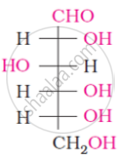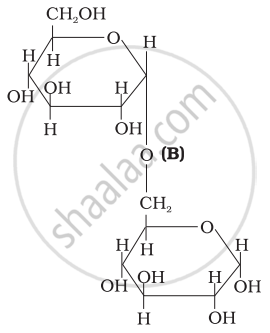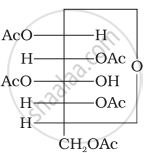Advertisements
Advertisements
प्रश्न
Write the reactions involved when D-glucose is treated with the following reagent:
Br2 water
What happens when D-glucose is treated with the following reagent?
Bromine water
उत्तर
\[\begin{array}{cc}
\phantom{........}\ce{CHO}\phantom{.............}\ce{COOH}\phantom{..}\\
\phantom{.}|\phantom{..................}|\\
\phantom{.......}\ce{(CHOH)4->[Br2 water](CHOH)4}\\
\phantom{.}|\phantom{..................}|\\
\phantom{............}\ce{\underset{\text{D-glucose}}{CH2OH}}\phantom{.........}\ce{\underset{\text{D-gluconic acid}}{CH2OH}}\phantom{.}
\end{array}\]
संबंधित प्रश्न
Write the product when D-glucose reacts with conc. HNO3.
Glucose on reaction with HI gives n-hexane. What does it suggest about the structure of glucose?
What do you observe when glucose solution is heated with Tollen’s reagent?
What do you observe when glucose is treated with bromine water?
Write the reactions involved when D-glucose is treated with the following reagent:
(CH3CO)2O
The following compound can be called as:

The spatial arrangement of the given molecule is denoted by:

Which of the following statements is incorrect regarding glucose?
The symbols D and L represents ____________.
When glucose reacts with bromine water, the main product is ____________.
Which of the following reactions of glucose can be explained only by its cyclic structure?
Choose the correct relationship for glucose and fructose:
Three structures are given below in which two glucose units are linked. Which of these linkages between glucose units are between C1 and C4 and which linkages are between C1 and C6?
| (I) |  |
| (II) |  |
| (III) |  |
Why does compound (A) given below not form an oxime?

(A)
Write the reactions of D-glucose which can’t be explained by its open-chain structure. How can cyclic structure of glucose explain these reactions?
On the basis of which evidences D-glucose was assigned the following structure?
\[\begin{array}{cc}
\ce{CHO}\\
|\phantom{....}\\
\phantom{..}\ce{(CHOH)4}\\
|\phantom{....}\\
\phantom{..}\ce{CH2OH}
\end{array}\]
Match List - I with List - II.
| List I | List II | ||
| (A) | Glucose + HI | (I) | Gluconic acid |
| (B) | Glucose + Br2 water | (II) | Glucose pentacetate |
| (C) | Glucose + acetic anhydride | (III) | Saccharic acid |
| (D) | Glucose + HNO3 | (IV) | Hexane |
Choose the correct answer from the options given below:
When D-glucose reacts with HI, it forms ______.
Give the reaction of glucose with hydrogen cyanide. Presence of which group is confirmed by this reaction?
